Book reviews
 |
 |
 |
 |
 |
 |
 |
The Valiant Attempts to Save
the French Monarchs
Book Review of The Avengers of the King by Jean Drault, trans. from French by Ryan P. Plummer, Lambfount, 2022, 384 pp.

A novel based on historical facts & personages
The family members are praying for success in their plan to save Louis XVI from execution that night, January 20, 1793. Praying with them is a priest, Fr. Edgeworth de Firmont, who will leave soon to hear the last Confession of the King and accompany him on his final journey.
The first of the three plots in the book recounts the efforts to free the King before his execution on that same night. The daring French Royalists – who termed themselves counter-revolutionaries – were members of an organization known as The Avengers. Their aim was to rescue the King and Queen, restore them to their thrones, and thus allow sanity and Catholicism to flourish again in France.
The book is very French in spirit. Much intrigue, many complicated romantic liaisons. Surprisingly, it includes actual source documents – newspaper reports, historical references, etc. – giving the reader the sense at times of a historical account vs. pure novel.
In fact, I verified that all the main characters in the book were real persons (the only one I could not confirm was Adéle, one of the romantic characters). Robespierre, Cécile Renault, the Sainte-Amaranthe family and other real characters are drawn with rigorous accuracy. The main events – the substance of the story – are also correct.
The novel, then, has the value of showing readers that a Counter-Revolution really did exist in France during the French Revolution. Contrary to the modern myths we are fed in American schools, there were many people – grand and small – who loved their King and Queen and were willing to sacrifice their lives to save them and restore the Monarchy.
The plan to free the King
The first plot to free the King failed, obviously, but it is refreshing to see the real passion of The Avengers in their attempt to save Louis XVI, and later, his family. What thwarted the attempt against the network, led by the heroic and bold Baron de Batz (alias the Reaper or Citizen Manaud) were small internal mistakes, such as forgetting to demand the password, messages unreceived, etc. (In fact, the author dedicates the book to Baron de Batz, a relative of the Royalist leader).

The King’s confessor Fr. Edgeworth
was part of the failed plot to free the King
There was a brief skirmish after the carriage was stopped, but not enough men were available to conclude the rescue; several were killed or captured. This fact escapes most history books, and while it was hard to watch the King proceed on the way to his death – unaware of his loyal subjects and guards who wanted to save him.
Two more failed plots
When this plot fails, the mission becomes that of avenging the death of the King.
March of 1793 is the time setting for the second plot, this time to free Marie Antoinette, her son and daughter, and the King's sister Élisabeth, all prisoners in the Temple Prison.
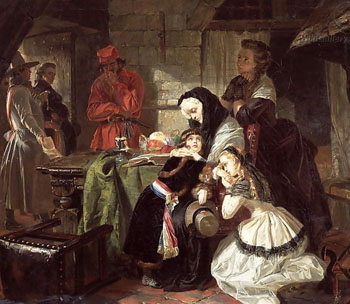
The Queen, under close watch, gives a last embrace to her son the Dauphin before he was taken from her
In the prison, the treatment of the royals was despicable: "These vicious insults are not spontaneous, since almost all those whose duty requires them to go to the Temple end up being seized with pity at the tragic circumstances, and being outraged at the despicably vile persecution. These things are deliberate, ordered, and paid for by the Masonic lodges who worked the Revolution, not only against the King of France, but against his people..." (p. 142)
Normal conversation was forbidden. Surveillance was constant, and even handkerchiefs were checked for special folds, creases or knots which could indicate a form of message.
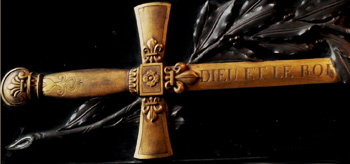
‘God and the King’ - the motto of the Royalists
This time, the plot was foiled by a change in timing: A mere hour before the designated time for the escape plan, the Queen was transferred from Temple Prison to the Conciergerie Prison, where the prisoners were held until a "trial" and the forgone execution would transpire.
The plots are suspenseful and can leave a sense of frustration that all ventures to intervene to spare the Royals were unfulfilled. Certainly, the author awakens compassion for the Royal Family and the Monarchist Cause. This, in itself, makes it a worthwhile read.
Romances & a flawed hero
The romances, however, can be a bit tiresome for the unromantic spirit. They are complicated and at times convoluted. For example, Paul de Lézardière is betrothed to his cousin, Adéle de Sainte-Pazanne, whose family had been slaughtered in their château by some sans-culottes (revolutionaries). Their guardsmen and servants died in their efforts to save the family (a far cry from the propaganda telling us aristocrats were hated by their servants).

Emilie Saint-Amaranthe,
considered the most beautiful woman of Paris
This enchanting Émilie captivates Robespierre and Sénar, a police detective who discerns who the Baron really is and follows him diligently, hoping to turn him in to gain a position of power and wealth. Meanwhile, Émilie joins The Avengers, and Adéle and she become close friends. This particular romance, which I will not describe any further, is one of the few happy endings in the novel.
One frustration I had was the detail the author spent on street names, describing avenues, edifice, buildings, etc – past and present – that means little to one unfamiliar with Paris. Another problem for me was in the relationship between Paul and Adéle. Her accusations were childish and baseless, their lack of communication baffling.
The Baron, presented as the hero, also seemed to me to have blaring faults that were ignored by the author: His overconfidence in his invincibility and lack of precaution led to many mishaps. Personally I had problems relating to him as the great leader as the author conveyed him. (He was one of the few Avengers actually to survive and live to an old age.)
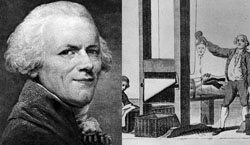
Robespierre, mastermind of the mass executions of the nobles & clergy
Robespierre was the mastermind of the massive executions that decimated France. His contradictory and ruthless character was well depicted. He justified his heinous deeds as "crushing the enemy" – the Monarchy – and did not hesitate "to sacrifice many of my old friends to not be compromised with them."
One of his goals was to "establish the worship of Reason and the Supreme Being, alone worthy of a great, regenerated people." (p. 311)
As for The Avengers, they fought for God and country and were willing to die for the Cause. As one remarks, "My death, at least, could be useful for the cause of Religion and King..." (p. 20) Even women were eager to help the cause: "I cannot fight like a man, but everyone in their own sphere can do useful work and contribute to the common plan," said one. (p. 21) Another insisted: "But what is one life, if the Counter-Revolution triumphs?" (p. 22)
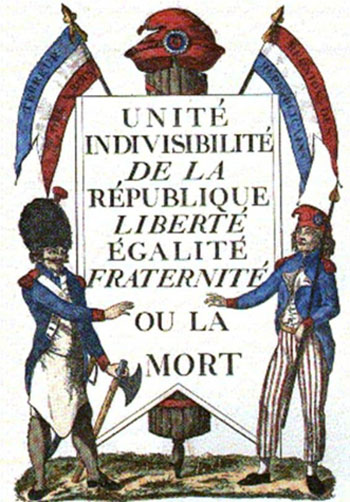
The revolutionary goal exposed:
‘Liberty, Equality, Fraternity - or Death!’
I would recommend this book to those who like to read a different perspective regarding the French Revolution. It reveals the side of the story seldom heard: how the Masons manipulated the populace to instigate the Revolution. The satanic nature of the anti-Catholic and anti-monarchical targets are presented in their horrific, evil and inhumane reality.
It also exposes the falsehood and absurdity of the revolutionary slogan of the sans-culottes: "Liberty, Equality, Fraternity!" There is only true liberty in following Christ; the only equality is that of the love God has for each of us; and fraternity comes with loving one's neighbor as oneself, as Our Lord Jesus Christ taught.
Our Lord Jesus Christ, have mercy on the "Church's Eldest Daughter!" Holy Mary, hear our prayers of supplication!
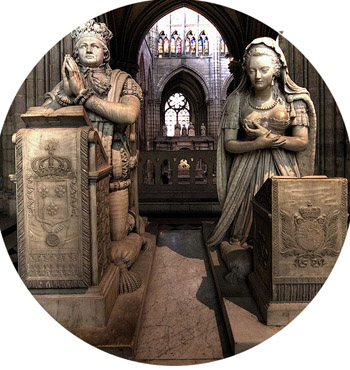
The tombstone of the Kings
Basilica of St. Denis, Paris
Posted October 21, 2022
______________________
______________________





